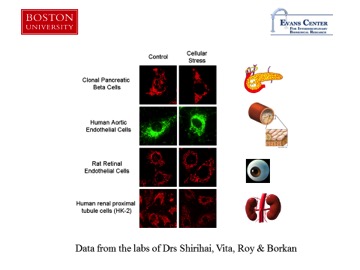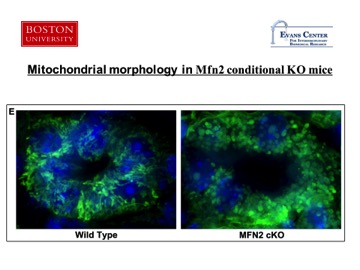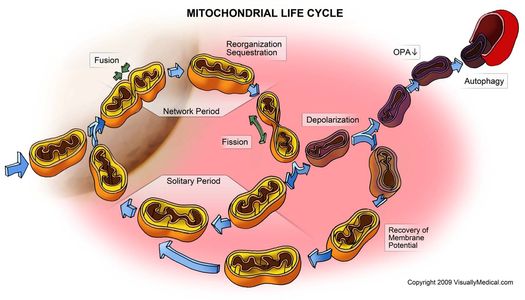Mitochondria ARC (mtARC): Mitochondrial Dynamics in Health
INITIATION DATE:
12.01.09
ARC DIRECTORS AND CO-DIRECTORS:
Director, Orian Shirihai; Adjunct Associate Professor; Medicine/Obesity/BUSM
Co-Dir, Andrea Havasi; Assistant Professor; Medicine/Nephrology/BUSM
Discovery highlight, March 2017:
Several research groups participated in our mitochondrial dynamics projects leading to multiple cutting-edge publications and new grant applications. One of our first projects investigated the role of mitofusin 2 (Mfn2) and mitochondrial dynamics in neurodegeneration and metabolic diseases in different organ systems. The mitoARC supported these studies by generating precise and invaluable research tools: Mfn2 adenoviral and oligo systems and mouse models with tissue specific deletion of Mfn2.
The value of mitoARC was demonstrated by the impact of the research tools it generated resulting in new discoveries: Parkin, a potential target for Parkinson’s disease, was shown in dopaminergic neurons to ubiquitinate and remove Mfn2 from depolarized mitochondria, thereby segregating dysfunctional mitochondria from the networking population. In work in endothelial cells Mfn2 was proposed to be a key protein responsible for arterial stiffness. Mfn2 was also studied in the retinal endothelium: Mfn2 might be a key regulator of diabetic retinopathy and it might be used as a drug target to alter diabetic complications in the eye. Another mitoARC lab investigated Mfn2’s role in ischemic renal injury and regeneration and published data using animal models developed by the mitoARC.


OVERVIEW OF GOALS AND MISSION, 2010-2013:
Abstract
The mtARC is comprised of 26 labs with shared interest in the role of mitochondria in physiology and pathophysiology. Diverse membership encompasses 12 sections/departments with representation from both the Medical and Charles River Campuses. In addition, membership includes labs from other universities and from industry.
The mtARC provides training and tools for investigating mitochondrial bioenergetics, dynamics and ROS in various systems, as well as develops cells lines and animal models to study different mitochondrial proteins. Our aim is to accelerate the study of mitochondrial function through education, service, and scientific advancement.
One of our main project is to study mitochondrial fusion and fission, collectively termed “Mitochondrial Dynamics”. These processes underlie the maintenance of a healthy mitochondrial population by permitting complementation of underperforming units and removal of dysfunctional units by autophagy. Of particular interest is the role of Mfn2 in the pathophysiology of disease. Mfn2 is essential for mitochondrial fusion and has been associated with CMT2A and more recently with obesity and diabetes. Members of the mtARC have been focusing on the role of Mfn2 in cardiovascular disease, metabolic complications, renal disorders, and neurodegeneration and in the mechanisms by which Mfn2 modulates apoptosis and ROS signaling.
ARC Members:
| *Orian Shirihai; Adjunct Assoc Prof; Director | Medicine/Obesity/BUSM |
| *Andrea Havasi; Assist Prof; Director | Medicine/ Renal |
| Marcia Haigis; Assist Prof | Harvard Medical School |
| *Steve Borkan; Assoc Prof | Med/Renal |
| *Richard A. Cohen; Prof | Medicine/ Vascular Biology |
| *Sayon Roy; Prof | Medicine/ Endocrinology |
| *Susan Doctrow; Research Assoc Prof | Medicine/ Pulmonary |
| *Joseph Vita, MD; Prof | Medicine/ Cardiology |
| *Benjamin Wolozin; Prof | Pharmacology |
| *Wilson Colucci; Prof | Medicine/ Cardiology |
| *Barbara Corkey; Prof | Medicine/ Obesity |
| *Paul Pilch; Prof | Biochemistry |
| Mario Cabodi; Res Assist Prof | Biomedical Engineering |
| Jude Deeney; Assist Prof | Medicine/ Obesity |
| Markus Bachschmid; Assist Prof | Medicine/ Cardiovascular |
| Nika Danial; Assist Prof | Dana Farber Cancer Inst |
| Madhumathi Rao; Assist Prof | Nephrology/ Tufts Univ Sch of Med |
| David Ferrick, CSO | Seahorse Bioscience |
| Brian Benoit | Seahorse Biosense |
| Alexei Degterev, Assist Prof | Biochemistry/ Tufts Univ Sch of Med |
| Victoria Bolotina; Prof | Medicine/ Cardiovascular |
| Daniel Levy; Prof | Med/Cardiology/Framingham Heart Study |
| *Susan Brogly; Assist Prof | Public Health/Epidemiology |
| Eric Bachman; Assist Prof | Novartis |
| Sherene Shenouda; Assist Prof | Medicine/ Cardiology |
| Nagendra Yadava | PVLSI |
| Steven Farmer; Prof | Biochemistry |
| Keith Tornheim; Assoc Prof | Biochemistry |
| Valentina Perissi; Assist Prof | Biochemistry |
| Anne-Marie Laroch | Pfizer |
| Lisa Norquay | Pfizer |
| Sean Elliot; Prof | Chemistry |
| Andrew Greenberg; Prof | Tufts University |
| Martin Obin; Prof | Tufts University |
| *Konstantin V. Kandror; Prof | Biochemistry |
| *Edward Miller; Assist Prof | Medicine/ Cardiology |
| *Mark Grinstaff; Prof | BU/ Biomedical Engineering/Biochemistry |
| Neil Ruderman; Prof | Medicine/Endocrinology |
MAIN ARC PROJECT(S) FOR 2009-2010:
The mitochondrial life cycle consists of frequent fusion and fission events. Ample experimental and clinical data demonstrate that inhibition of either fusion or fission result in deterioration of mitochondrial respiratory function. Moreover, alterations in the balance between fusion and fission activity influence cell proliferation and apoptosis. Recent data indicate that mitochondrial fusion and fission execute their effect on mitochondrial bioenergetics by affecting the ability of mitochondria to deal with ROS; conversely, changes in mitochondrial fission largely impact ROS production by mitochondria.
Of the regulators of mitochondrial dynamics, mitochondrial fusion protein 2 (MFN2) has attracted the attention of multiple labs in the mtARC. Results from a number of labs indicate that alterations in the levels and function of Mfn2 play a role in diabetes and cardiovascular disease. In beta and endothelial cells, changes in Mfn2 were triggered by nutrient induced oxidative stress, suggesting the possibility that similar mechanisms affect mitochondrial dynamics in different tissues leading to diverse phenotypes.
The goals of the ARC project is to determine the role of mitochondrial dynamics, and in particular Mfn2, in the pathophysiogy of multiple diseases of interest. We rationalized that focusing on one mediator of mitochondrial dynamics, i.e. Mfn2, will allow the group to generate valuable molecular and genetic tools that can be used for the study of several disease models and that any mechanistic information revealed in one disease model could be then tested in the other models, amplifying the impact of each discovery.
RESEARCH PROGRESS 2009-2013:
The MitoARC has built a new research area at BU/BMC centered on mitochondria in health and disease. This includes interactive platforms in the form of educational workshops for trainees and faculty in mitochondrial imaging and bioenergetics, min-symposia, seminars and research meetings. During the past three years, the mitoARC group worked collaboratively, with investigators from different backgrounds and with different expertise, all focused on understanding of the role of mitochondrial function and dynamics in multiple systems. Key discoveries in the first year included elucidating the role of mitochondrial dynamics in white adipocytes (Corkey), in brown adipocyte (Shirihai), in the pancreatic beta cell (Corkey; Shirihai), in neurons (Wolozin), in proximal tubule epithelium (Borkan; Havasi) and in the endothelial cells (Vita; Roy; Cohen). With investigations of such multifaceted systems, we are well posed to explore common mitochondria-dependent processes in different systems, and hence, common pathological mechanisms in different organs. This exemplifies the power the ARC paradigm in advancing multifaceted research of complex systems.
Drs. Wolozin & Shirihai have worked in collaboration to develop a new technique for quantification of mitochondrial motility in Parkinson’s disease models. Drs. Shermans & Shirihai have developed an approach for the quantification of mitochondrial turnover in cultured cells which was also adopted to C. elegans by Dr. Wolozin and used in the study of Parkinson’s disease. These developments supported a program project (NIH/ NINDS -Udall Center) application in the labs of Drs. Wolozin, Sherman, Shirihai & Collins. Although the first round of this NIH application was not funded, a subsequent grant was funded by a biotech company, Link Medicine, thereby forming the basis for productive industry collaboration. Link Medicine utilized and further developed the above methods.
The labs of Drs. Corkey & Shirihai described the role of Mfn2 in pancreatic beta cell adaptation to gluco-lipotoxicity. This discovery was made possible, in part, by mtARCresources, including two microRNA constructs for Mfn2. These findings were used as preliminary data in a RO1application. In this grant they proposed to use the Mfn2 transgenic mouse that is being developed by the mtARC. Mfn2 ES cells (which include Mfn2 gene floxed) were produced during the past funding period, and these cells were injected at the BU transgenic core. The chimeras were not fertile, therefore a second round of injections was planned.
The mtARC and the Fat&Sex ARC (headed by Drs. Fried & Pilch) have joined forces in organizing the Brown Adipocyte and Uncoupling Symposia (Jan Nederaad & Barbara Cannon) and co-hosting the talk of Saverio Cinti on brown adipocyte imaging. These interactions lead to stimulating discussions and collaborations and finally to a new PO1 application focusing on the regulation of energy efficiency of brown adipocytes (BAT). The mtARC members in this PO1 are: Paul Pilch, Kostya Kandror, Orian Shirihai & Barbara Corkey. In this grant Drs. Shirihai & Corkey proposed to investigate the role of mitochondrial fusion and fission in BAT activation for energy expenditure. Dr. Pilch in his preliminary experiments described the role of a new redox protein in the uncoupling in BAT. His experiments were done under the guidance of the mtARC using techniques the ARC developed to study mitochondrial bioenergetics. In this project, Dr. Kandror proposed to test the role of a newly described transcription factor in the induction of UCP1 and in the activation of changes in mitochondrial architecture.
A number of companies joined the mtARC and also signed agreements with ARC members. Two students (L. Stiles/Shirihai Lab; A. Feree/Wolozin Lab) received stipends provided by these companies. Pfizer, Seahorse Bioscience, Dynamix Pharmaceuticals, Link Medicine and Molecular Cytomics have signed research agreements with members of the mtARC (over $600K). Novartis has joined the mtARC. To a large extent, the existence of the mtARC played a key role in bringing these companies to BU. Seahorse Bioscience has provided the mtARC with a new technology for measurement of Krebs cycle in a high throughput manner, which was available to the mtARC members before being available to outside institutions.
Application for a PO1 grant on testosterone as a regulator of mitochondrial ROS in the process of aging: Drs. Guo, Bahsin & Shirihai participated in this large PO1 grant that intends to investigate the effect of testosterone replacement therapies on mitochondrial ROS in the elderly. This work was made possible by the contribution of Seahorse Bioscience to the mtARC. This contribution included an XF24 at a cost of $120K.
Research progress 2012-2013
We continued the fruitful mitochondrial dynamics projects and expanded our work on mitochondrial ROS, building on a novel paradigm developed by our ARC members.
Project 1: The role of mitofusin 2 (Mfn2) and mitochondrial dynamics inneurodegenearation and metabolic diseases.
The 2010-2011 funding period was devoted to generating adenoviral and oligo systems and mouse models with tissue specific deletion of Mfn2. In 2011-2012 two new labs joined in to investigate Mfn2 in different organ systems. This year, the floxed Mfn2 transgenic ES cells were obtained and the transgenic mouse will be used in the following projects:
Participating labs and their projects:
Dr Wolozin is using the Mfn2 KO and over-expression systems in dopaminergic neurons. Rational: Parkin has been shown to ubiquitinate and remove Mfn2 from depolarized mitochondria, thereby segregating dysfunctional mitochondria from the networking population. In his experiments he will confirm this function of Parkin as a potential target for Parkinson’s disease.
Dr Cohen (Arterial Stiffness ARC) is using the Mfn2 transgenic mouse to test the effect of Mfn2 over-expression in endothelial and smooth muscle cells under high fat diet. Their data suggest that Mfn2 is a key protein responsible for arterial stiffness. This project provided opportunity for collaborations between ARCs, as also advocated (Cross ARC collaborations) and encouraged by Dr. Ravid.
Drs Corkey & Shirihai submitted an NIH RO1 grant in which they proposed to use a Mfn2 over-expression model that was developed by the mtARC. They submitted preliminary data in this regard.
Dr Roy is using the Mfn2 floxed mice (both KO and transgenic) to test the role of Mfn2 in the retinal endothelium. Preliminary data shows that Mfn2 is reduced in response to hyperglycemia. The animal models developed by the mtARC will help him to test whether Mfn2 is a key regulator of diabetic nephropathy and if it can be used as a drug target to alter diabetic complications in the eye.
Dr Borkan is using the Mfn2 floxed mice to investigate its role in ischemic renal injury and regeneration and published his data using our animal model.
Project 2: ABCme as a novel anti-ROS system.
ABCme is an ATP Binding Cassette transporter expressed in the inner membrane of the mitochondria. Two years ago four labs, all ARC members, joined efforts in investigating the role of ABCme in cardiac function that resulted in a publication in Circulation. Using the mtARC funds we have generated the ABC-me floxed mice with the help of the transgenic core. The following groups will use this mouse model and the already existing total KO mouse provided by the Shirihai lab.
Participating labs and their projects:
The following organs systems are being studied in these animal models:
Dr Miller is investigating the role of ABC-me in ischemic pre-conditioning. He plans to submit a grant on this subject together with Drs Colucci & Shirihai. He will use the heterozygous mouse and also the tissue specific KO mouse generated by the ARC.
Dr Colucci is exploring the role of ABCme in high fat diet induced cardiomypathy. He has solid data demonstrating the role of ROS in this model.
Drs Liesa & Shirihai are studying liver specific KO mice to study metabolism.
Drs Miller & Colucci are using this mouse to produce supplementary data for the multi-PI grant submitted by Shirihai, Colluci & Miller. This grant will explore the role of ABC-me in aging related cardiomyopathy.
Dr Havasi is exploring the role of ABCme in kidney ischemia/reperfusion using an inducible Cre in the proximal tubule.
Dr Shirihai is studying the role of ABC-me in other key tissues where his lab has documented a role in the heterozygous mice. Shirihai hopes that these novel roles of ABC-me will be used to establish a program for Dr. Marc Liesa in his future quest to establish his own independent program.
Dr Danial (Harvard) is exploring the role of ABC-me in neuronal ischemia.
Dr Roy is studying ABC-me in the retinal endothelium using eye injections of viruses inducing Cre expression under VEGF receptor promotor. Dr. Roy is submitting a manuscript describing the role of ABCme in the protection of the retinal endothelium from ROS induced apoptosis in the hyperglycemic mouse.
In 2012-13 the following labs were trained by the mitoARC:
Ronglih Liao (Harvard, imaging mitochondrial morphology, autophagosomes, ROS), Raul Mostolavsky (MGH, respirometry), Nabeel Bardeesy (respirometry), Nika Danial (imaging mitochondrial dynamics), Marcia Haigis (imaging mitochondrial dynamics), Respirometry, imaging mitochondrial dynamics: Pfizer, Borkan, Bardeesy (MGH), Miller, Vita, Nick Dyson (MGH); Respirometry: Corkey, Fried, Ruderman, Saha, Borkan, Nikolajczyk, Raul Mostoslavsky, Hamilton, Pilch, Guo
ARC AS A RESOURCE:
A group of labs at the mtARC will form the mtARC-Core that will provide tools and guidance to facilitate the use of technologies to be applied in all systems below. The mtARC-Core includes A. Bioenergetics (Drs. Shirihai, Ferrick), B. Imaging (Dr. Molina), C. ROS (Drs. Doctrow, Cohen, Goldstein), D. Molecular , including Mfn2 expression viruses and transgenic mice. and E. human Genetics (Dr. Schwartz and Dr. Levy).
Pictures, Images, Figures:
